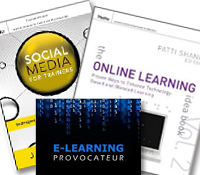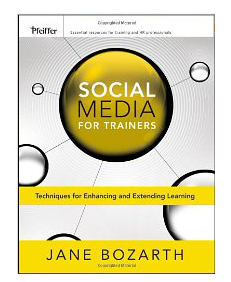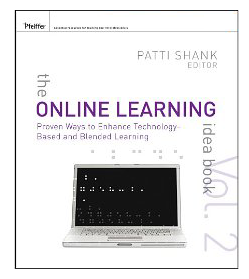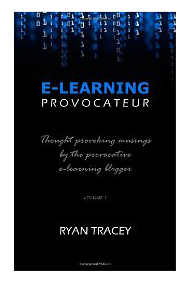Do you wa nt to tap into the power of social media for learning? Are you looking for new ideas to climb out of a slump? If the answer is “yes,” then check out the three books by eLearning experts below.
nt to tap into the power of social media for learning? Are you looking for new ideas to climb out of a slump? If the answer is “yes,” then check out the three books by eLearning experts below.
Listed in alphabetical order by author, you’ll find Jane Bozarth’s Social Media for Trainers, Patti Shank’s The Online Learning Idea Book, and Ryan Tracey’s E-Learning Provocateur.
All three authors write from years of experience and share unique practical advice, strategies and philosophy.
As one who foresaw the relevance of social media in workplace learning, Jane Bozarth spells it out in her book Social Media for Trainers.
She’ll convince you there are big payoffs when social media strategies supplement or supplant traditional training (as appropriate). Social media facilitates autonomy and independence in learning and promotes awareness of one’s learning process. But most important, social media technologies can support learning and their application in the workplace. This is because social media often parallels how we learn in the “real world.”
Social Media for Trainers explores the social media approaches with the most significant potential to facilitate learning. The book concentrates on Twitter, Facebook, blogs, and wikis. It also covers other tools, including Google Docs, YouTube, and SlideShare.
Jane points out that tools are merely a means to an end. The end goal is most important for your audience. You can implement any of the approaches using a similar tool. For example, the strategies offered in the Twitter chapter could also work in Yammer or any microblogging tool.
For each key social media approach, Jane introduces the tool, explains its advantages and disadvantages, and tells how to get started. Then, the real fun begins. She provides dozens of compelling ideas for using a particular tool pre- and post-training, as part of training, and between training sessions.
You’ll learn how to do a Round Robin on Twitter or use it to practice a foreign language. You’ll see how to use Facebook to host a discussion with an expert and have learners post examples of a newly learned concept. You’ll learn to use blogging and wikis to support debates, show e-portfolios, and share final projects.
In addition to all the helpful suggestions, Social Media for Trainers includes tips for becoming a change agent in your organization and selling change to others.
If you’re looking for ways to provide additional support to workforce training, if you want to create richer learning experiences, or if you simply know that the time for Web 2.0 has long arrived, then you’ll love Social Media for Trainers.
The Online Learning Idea Book (Volume 2) by Patti Shank, PhD.
If you’ve already used every idea you can drum up, you need The Online Learning Idea Book (Volume 2) by Patti Shank. This book is one great idea in itself. It’s like sharing an office with smart members of the eLearning community, drawing on the suggestions from a wide range of contributors.
The Online Learning Idea Book Volume 2 is as well-organized as you’d expect from an eLearning pro. The book includes ideas for:
- The design and development process.
- Supporting learners and learning.
- Synchronous and social learning.
- Self-paced learning.
- Media and authoring.
Every idea is covered from several angles. The “What” and “Why” sections introduce each idea. Then, the “Use It!” section provides an extended description of implementing the idea, tips, examples, and corresponding screen captures or visuals (charts, checklists, etc.).
The “Adopt or Adapt” section is excellent, because it provides ways to modify each idea for different circumstances. All of this is followed by an “Attribution” section with a generous paragraph about each contributor.
The breadth of ideas in this book is impressive. “Design and Development” starts out with aligning objectives, moves on to a complexity analysis, and ends with story-based learning.
In later chapters, you’ll find ideas as varied as helping teams follow rules of engagement, using Twitter to develop a personal learning network, supporting collaboration and learner feedback, implementing clip art surgery in PowerPoint, and reducing online text. The supporting visuals add a lot to make it all concrete and tangible.
Junior and mid-level instructional designers will get lots of value from this book. And don’t be surprised if senior-level designers peek at it, too. There are new ideas for everyone here. And if you need even more ideas, check out Patti’s Online Learning Idea Book Volume 1, which has 95 more proven ideas.
E-Learning Provocateur by Ryan Tracey
Ryan Tracey’s E-Learning Provocateur is a collection of essays and articles gleaned (and some modified) from his blog of the same name. Ryan covers a gamut of topics that might be of interest to instructional designers and eLearning specialists.
He runs through some instructional design basics, such as analysis, learning theories, the power of using visuals, and blended learning. He also delves into social media for learning, effective virtual facilitation, and a variety of learning technologies. Although a few of the articles now seem dated (cloud-computing; Twitter is good) most stand the test of time.
In a unique article, Ryan integrates theory and practice by proposing that we keep in mind four different learning theories when designing a learning experience. He then lists practical ways to use each theory to inform one’s work. There are tips for implementing design from Behaviorist, Cognitivist, Constructivist and Connectivist perspectives.
The book and blog title come from the fact that Ryan is a contrarian at times. Although he doesn’t propose anything too radical, he does successfully punch holes in the status quo, when appropriate. In this department, you’ll find the idea that most online learning could also be distributed as a PDF document; spirituality in the workplace; and the opinion that text isn’t half-bad.
Personally, I’d like to see this book organized into sections or chapters. It would be interesting to read the related essays together and to compare ideas. This would provide more depth on each topic too.
In summary, there may be many in this eLearning universe who faithfully do their jobs but don’t consider the deeper side of eLearning. E-Learning Provocateur can fill this gap.




Leave a Reply